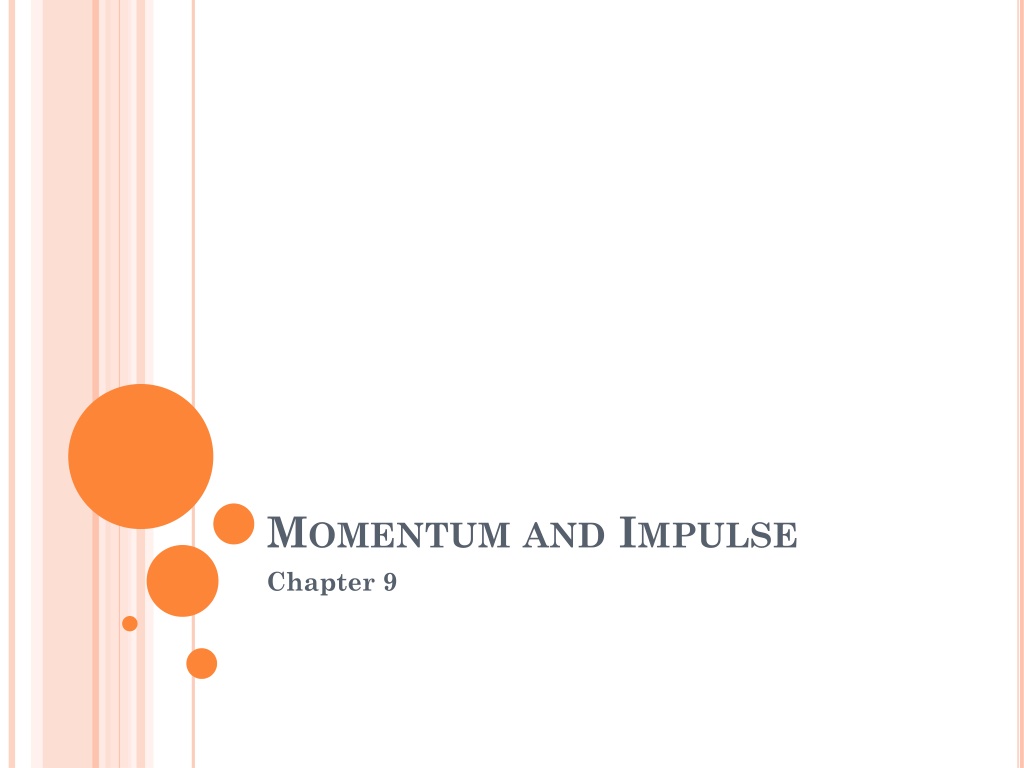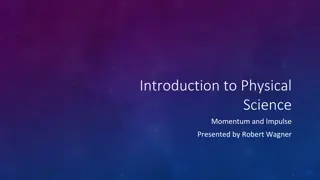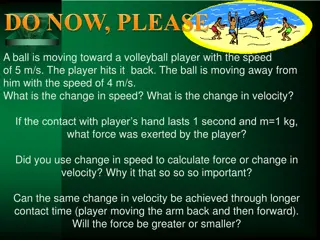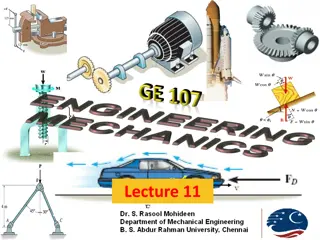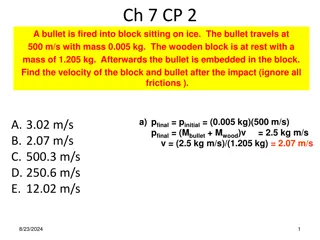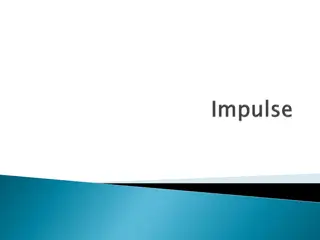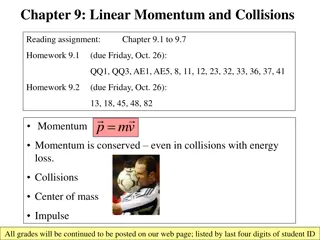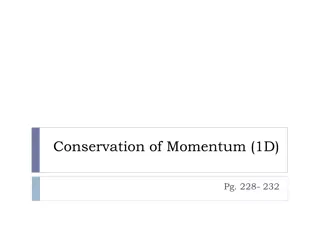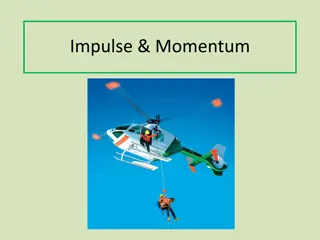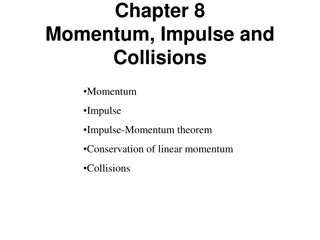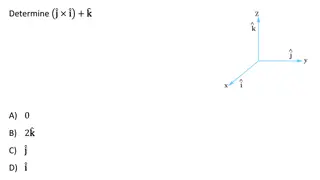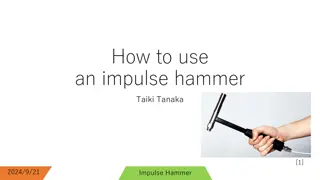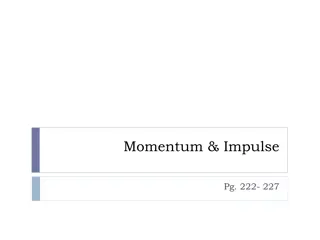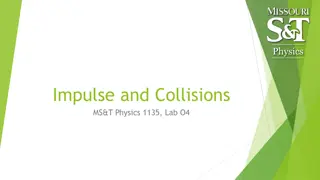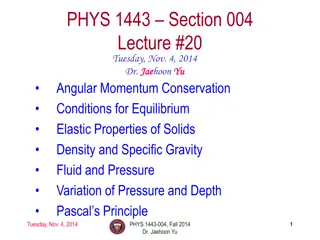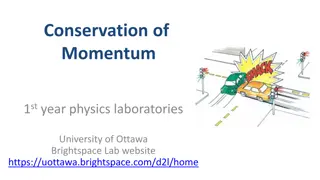Understanding Momentum and Impulse in Physics
Explore the concepts of momentum and impulse in physics, including the definition of momentum, the impulse-momentum theorem, and how factors affect object motion post-collision. Discover how momentum plays a vital role in describing an object's motion and learn about the relationship between force, time, and momentum.
Download Presentation

Please find below an Image/Link to download the presentation.
The content on the website is provided AS IS for your information and personal use only. It may not be sold, licensed, or shared on other websites without obtaining consent from the author. Download presentation by click this link. If you encounter any issues during the download, it is possible that the publisher has removed the file from their server.
E N D
Presentation Transcript
MOMENTUM AND IMPULSE Chapter 9
What factors affected how fast objects move after a collision? (Think of your lab)
SECTION 1: MOMENTUM AND IMPULSE Linear Momentum: Momentum is defined as mass times velocity. Momentum is represented by the symbol p, and is a vector quantity. p = mv momentum = mass velocity Momentum describes an objects motion SI unit for momentum is kg m/s The faster you move, the more momentum you have and the more difficult it is to stop.
Did you know? Momentum is so fundamental in Newton s mechanics that Newton simply called it a quantity of motion. The symbol p, comes from Leibniz s (mathematician that developed calculus independently of Newton) us of the term progress, defined as the quantity of motion with which a body proceeds in a certain direction.
Example 1: A 2250 kg pickup truck has a velocity of 25 m/s to the east. What is the momentum of the truck?
Impulse-Momentum Theorem Impulse The product of the force and the time over which the force acts on an object is called impulse. The impulse-momentum theorem states that when a net force is applied to an object over a certain time interval, the force will cause a change in the object s momentum. F t = p = mvf mvi force time interval = change in momentum
Example 1: A 1400 kg car moving westward with a velocity of 15 m/s collides with a utility pole and is brought to rest in 0.30 s. Find the magnitude of the force exerted on the car during the collision.
Stopping times and distances depend on the impulse- momentum theorem. F t = p
Force is reduced when the time interval of an impact is increased. Example: A large force exerted over a short time (a) causes the same change in the egg s momentum as a small force exerted over a longer time (b).
SECTION 2: CONSERVATION OF MOMENTUM Momentum is conserved The Law of Conservation of Momentum: The total momentum of all objects interacting with one another remains constant regardless of the nature of the forces between the objects. m1v1,i+ m2v2,i= m1v1,f+ m2v2,f total initial momentum = total final momentum
How do the force exerted on the stationary ball in Figure 1 and the time interval over which it is exerted compare with the force exerted on the stationary ball on the opposite end and its corresponding time interval? A: The forces are equal in magnitude and opposite in direction (Newton s 3rdlaw), and the time intervals are also equal. How would you determine the change in moment of each ball? A: The change in momentum of each ball must be equal in magnitude but opposite in direction because p = F t Momentum is conserved in collisions and for objects pushing away from each other
CONSERVATION OF MOMENTUM WITHOUT EXTERNAL FORCES Example 1: Two people on skates push against each other. The person on the left is 50 kg, the person on the right is 60 kg. If the person on the right ends up going 3 m/s, how fast is the other person going?
Example 2: A 6 kg object going 3 m/s to the right hits a 4 kg object going 4 m/s to the left. If afterward the 6 kg object ends up going 4 m/s to the left, find out what happens to the 4 kg object.
Example 3: A .25 kg arrow going 35 m/s is shot into a 6 kg target. The target is on wheels, so find how fast it will roll backwards.
Newtons third law leads to conservation of momentum During the collision, the force exerted on each bumper car causes a change in momentum for each car. The total momentum is the same before and after the collision. Forces in real collisions are not constant When solving impulse problems, you should use the average force during the collision as the value for force
CONSERVATION OF MOMENTUM WITH EXTERNAL FORCES ???????? ? = ?????? Impulse can change momentum. Ex 1: A 2 kg mass going 1 m/s is pulled by an 8 N force for 4 seconds. How fast is the mass going afterwards?
SECTION 3: ELASTIC AND INELASTIC COLLISIONS Inelastic Collisions A collision in which two objects collide and separate, but kinetic energy is not conserved. Is momentum still conserved? yes Where does the energy go? It is turned into sound, damaged objects, or heat.
Example: You and a friend are driving home from the football game. The car has a mass of 1650 kg and is at rest at a stop sign. A 2000 kg car with a velocity of 9 m/s doesn t see the stop sign and runs into your car. After the collision, you move at a velocity of 3 m/s.
Example Continued: m1= 1650 kg v1i= 0 m/s v1f= 3m/s m2= 2000 kg v2f= ? v2i= 9 m/s What is the final velocity of the 2 kg object? m1v1i+ m2v2i= m1v1f+ m2v2f (1650)(0) + (2000)(9) = (1650)(3) + (2000) v2f 0 + 1800 = 4950 + (2000) v2f v2f= 6.5 m/s What was the KEbefore? KEbefore= m1v1i2+ m2v2i2= (1650)(02) + (2000)(92) = 81,000 J What was the KEafter? KEafter= m1v1f2+ m2v2f2= (1650)(32) + (2000)(6.52) = 49,675 J Was KE conserved? Do you expect there was damage? No; Yes, KEafteris less What kind of collision was it? Inelastic
SECTION 3: ELASTIC AND INELASTIC COLLISIONS Perfectly inelastic collision A collision in which two objects stick together after colliding and move together as one mass is called a perfectly inelastic collision. Conservation of momentum for a perfectly inelastic collision: m1v1,i+ m2v2,i= (m1+ m2)vf total initial momentum = total final momentum
Example 1: A 1850 kg luxury sedan stopped at a traffic light is struck from the rear by a compact car with a mass of 975 kg. The two cars become entangled as a result of the collision. If the compact car was moving at a velocity of 22.0 m/s to the north before the collision, what is the velocity of the entangled mass after the collision?
Example 1 Continued: m1= 1850 kg v1i=0 m/s v2i= 22 m/s vf= ? m2= 975 kg m1v1i+ m2v2i= (m1+ m2) vf (1850)(0) + (975)(22) = (1850 + 975)( vf) 0 + 21,450 = 2,825( vf) vf= 7.6 m/s
Kinetic Energy is not constant in inelastic collisions because they are deformed Example 1: Two clay balls collide head-on in a perfectly inelastic collision. The first ball has a mass of 0.500 kg and an initial velocity of 4.00 m/s to the right. The mass of the second ball is 0.250 kg, and it has an initial velocity of 3.00 m/s to the left. What is the final velocity of the composite ball of clay after the collision? What is the decrease in kinetic energy during the collision?
Example Continued: m1= .5 kg v1i= 4 m/s vf= ? m2= .25 kg v2i= -3 m/s m1v1i+ m2v2i= (m1+ m2) vf (.5)(4) + (.25)(-3) = (.5 + .25) (vf) 2 + -.75 = .75(vf) vf= 1.67 m/s
Elastic Collisions A collision in which the total momentum and the total kinetic energy are conserved is called an elastic collision. Kinetic energy is conserved in elastic collisions Momentum and Kinetic Energy Are Conserved in an Elastic Collision: Remember: if v is positive if the object moves right and negative if it moves left.
Example 1: A 0.015 kg marble moving to the right at 0.225 m/s makes an elastic head-on collision with a 0.030 kg shooter marble moving to the left at 0.180 m/s. After the collision, the smaller marble moves to the left at 0.315 m/s. Assume that neither marble rotates before or after the collision and that both marbles are moving on a frictionless surface. What is the velocity of the 0.030 kg marble after the collision?
Example 1 Continued: m1= .015 kg v2i= -.18 m/s m1v1i+ m2v2i= m1v1f+ m2v2f (.015)(.225) + (.03)(-.18) = (.015)(-.315) + (.03) v2f .0034 + -.0054 = -.0047 +(.03) v2f v2f=.09 m/s v1i= .225 m/s v1f= -.315 m/s m2= .03 kg v2f= ?
Impulse Graphs Impulse graves show the force applied to an object over time. Do not mistake the shape of an impulse to mean the direction the object is moving because it shows force, not distance. The area underneath your graph is equal to the impulse on the object. Impulse can be positive or negative.
Example: Triangle: bh Rectangle: bh Graph 1: Graph 2: Total: -6 + -18 + -6 = -30 kgm/s A (2)(15) = 15 B (2)(15) = 30 C (3)(15) = 22.5 Total: 15 + 30 + 22.5 = 67.5 kgm/s D (2)(-6) = -6 E (3)(-6) = -18 F (1/2 (2)(-6) = -6
Type of Collision Diagram Description Momentu m Kinetic Energy Objects Combine ? Elastic The two objects bounce after the collision and move separately Conserved Conserved No Inelastic The two objects deform during the collision so that they total kinetic energy decreases, but the objects move separately after colliding. Conserved Not Conserved No Perfectly Inelastic The two objects stick together after the collision so that their final velocities are the same. Conserved Not conserved Yes
